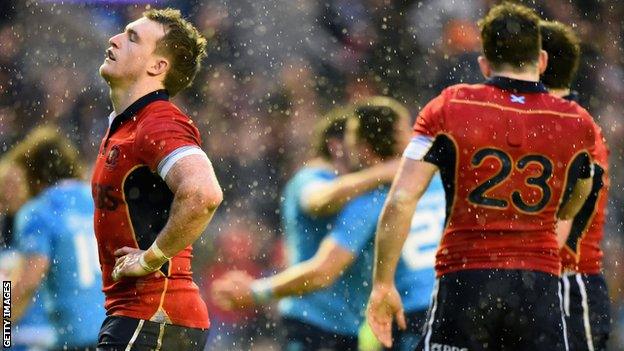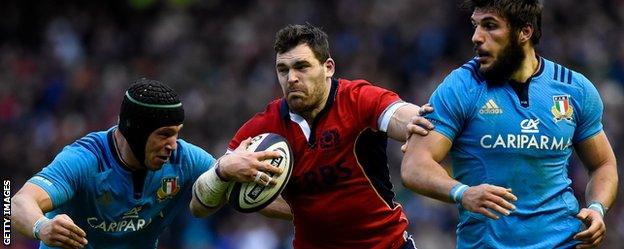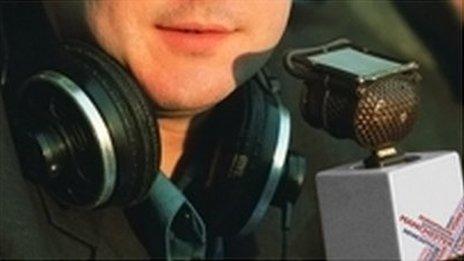Six Nations 2015: How Scotland lost to Italy - Mike Blair
- Published

Scotland's defeat leaves them without a point after three Six Nations games
There is no doubt that the 22-19 loss to Italy is a very disappointing result for Scotland. Many, including myself, had predicted a fairly comfortable victory - so what went wrong?
I thought the critical moment in the rhythm of the game occurred in the ninth minute. Scotland had just scored and had moved 10 points ahead, heads were high and the Italian body language was: "Here we go again."
Kelly Haimona kicked off too long and, rather than Sean Lamont leaving the ball completely or straddling the touchline and catching the ball to give Scotland a scrum back on the half-way, there was a mix up and Italy had the line-out possession and then the driving maul try. Game on.
Two things were missing; communication from someone in a better position to Lamont as to what his action should be and Lamont knowing where his touchline is. If you start on the touchline, you can always work your way infield once the kick-off is made.
This wasn't the only error straight after Scotland had scored points. It's an absolute momentum killer.
Italy had one major threat and, for all of Scotland's ambition and nice touches in attack, it meant absolutely nothing against the solid, efficient, well constructed and workman-like maul. Italy had clearly identified this as an area of weakness in the Scottish defence as they not only drove the ball from line-outs but also in open play, where they are often harder to defend.

Sean Lamont's poor decision-making on the touchline was only one of several Scottish mistakes
Coming up against strong driving teams, you could look to keep the opposition guessing about whether you are going to engage in the line-out or not. If you sit off the line-out maul then the catcher has to react to whether he has to transfer the ball or keep it; the support players don't know whether to drive aggressively forward or set the formation before advancing.
It puts doubt in the mind and means the attacking team don't have quite the same conviction in their drills. You don't do it every time, but you have it in your artillery. Using it on the second last line-out, on the 22m line, would have been the ideal time. Make the opposition react and give them different pictures.
With the open play mauls, you need the defence to have the same mindset as each other. Are you chopping at the legs, sacking the ball carrier, taking out the support or driving it back? Whatever happens here, you can't let it form because you saw what happens when it does. You need to create chaos, tackle the ankles, twist and turn the bodies. Don't let it set.
I thought the attacking shape looked good at times, especially in the first half, but a few minor adjustments might make the difference. They also need to maintain their shape and structure throughout the game as they looked slightly more ragged and unstructured as the pressure came on.
Scotland's first possession was bold, incisive and resulted in a 60-metre gain. The ball was thrown from side to side before Greig Laidlaw's perfectly judged kick give Italy a line-out inside their own 22m.
I think there was an opportunity missed though. After Alex Dunbar's break, Laidlaw stepped in at 10 to create the width, shipping it on to Mark Bennett in centre field and Scotland were clear numbers up. However, outside Bennett there was a cluster of forwards followed by Sean Lamont out on the wing and the opportunity was lost.

Italy's win at Murrayfield was their first in this season's Six Nations
I think Lamont needs to work his way into midfield so that three backs can work in unison and manipulate the defence. Leave one of the mobile forwards to keep the width.
There were some really promising support lines from breaks and half breaks leading into the 22m. Scotland just need to find that pass now. Expect that support to be there, running up the 'fat man channel'.
I was slightly confused by one George Clancy call near the end of the game. Italy were mauling hard, near Scotland's line, and Sam Hidalgo-Clyne managed to get his hands on the ball. The maul collapsed, legally, entitling Hidalgo-Clyne to maintain his position in the maul, latching on to the ball - even when the maul collapses to the floor - and that should have resulted in a turnover as the ball was unplayable.
However, as the maul collapsed, Clancy was heard shouting several times for him to release the ball. One beautifully orchestrated open-play maul later and it was game over. I'd love to hear the reason why Hidalgo-Clyne had to release.
I watch the French Top 14 highlights on TV5 Monde on a Sunday morning and the referees are actually interviewed after some games and asked to explain decisions they've made. We tend to shelter the referees a bit here and, as long as it's not just a witch hunt, it would be good to hear the rationale for certain calls straight from the horse's mouth.
- Published2 March 2015

- Published2 March 2015

- Published5 March 2015

- Published14 September 2016
